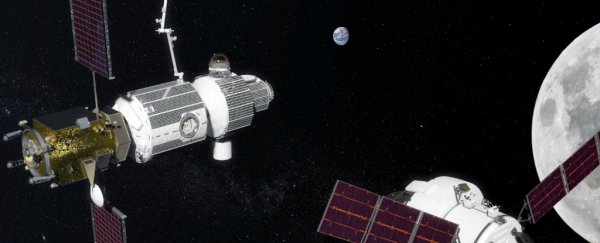In Spring of 2017, NASA revealed their plans for what the massive Space Launch System (SLS) rocket would be used for: to build the Deep Space Gateway, a space station in cis-lunar orbit that'll serve as a stepping stone to the exploration of the Solar System.
Until today, it was assumed that this would be a NASA project, with the agency constructing the station over the course of several launches of the SLS from 2021 through 2026, delivering the 4 major modules. The details were hazy, though, with the various components in development with various contractors.
Today, however, NASA and the Russian Space Agency Roscosmos announced that they'll be building the Deep Space Gateway together. They signed an agreement in Australia at the 68th International Astronautical Congress in Adelaide, Australia, and announced the news to the world.
What will Russia be contributing? According to TASS, Russian officials said that they'd be providing one to three modules for the station, as well as the docking mechanism that spacecraft would use when approaching the station.
Russia also offered to carry some of the station parts on their new super heavy lift rocket. They didn't specify the rocket, but that sounds like the Angara rocket which is in development, and is expected to make its first flights over the next few years.
The Deep Space Gateway will serve as the primary destination for NASA's human space exploration efforts, once the SLS and Orion Crew Module are completed. The first launch of SLS will carry an unmanned Orion capsule on a trans-lunar flight in 2018. Then SLS will be used to blast the Europa Clipper off to the Jovian system.
Their original strategy was to launch some time between 2021 and 2023 carrying the Solar Power Electric Bus module to the station, followed by the Habitation Module in 2024, the Logistics Module in 2025 and finally the Airlock Module in 2026.
At this point, NASA has solicited proposals from various aerospace contractors for the development of the Power Module, and Habitation System, and they didn't indicate that Russia's involvement would have any impact on the construction of these modules.
With the Russians announcing their involvement, we don't really know how this'll impact the structure of the station or its configuration of modules. This might also be an incentive for other space agencies (like the newly announced Australian Space Agency) to come on board.
Of course, the Russians were involved in the construction of the International Space Station. They provided the Zarya module for propulsion and navigational guidance, then the Zvezda for living quarters, and the Pirs, Poisk and Rassvet docking modules.
They've also provided half the support of the station, including astronauts, and provide the only way to get humans up to the station, on their Soyuz rockets.
Until recently, Russia had been threatening to pull their support of the International Space Station, before it was ready for retirement. But earlier this year, they agreed to support ISS until 2024, and even to 2028 if necessary.
They've also been continuing work on their Multi-Purpose Laboratory Module (MLM), which was originally planned for launch in 2007, and is now expected to be attached to the station some time in 2018.
Before announcing their involvement with the Deep Space Gateway, Russia had said that they'd probably be investing in the development of their own orbital space station once the ISS mission was over. They're also apparently working on a robotic lunar orbiter and lander mission.
This isn't the only announcement involving the Deep Space Gateway. It might also get a solar sail.
Engineers from the Canadian Space Agency proposed attaching a small solar sail to the Gateway, which could serve in re-orienting the space station without needing propellant.
It would have a surface area of about 50-meters, and would save hundreds of kilograms of hydrozine fuel which would normally be used over the lifespan of the Deep Space Gateway.
Check out Anatoly Zak's excellent reporting on this development for the Planetary Society.

This article was originally published with Universe Today. Read the original article.
